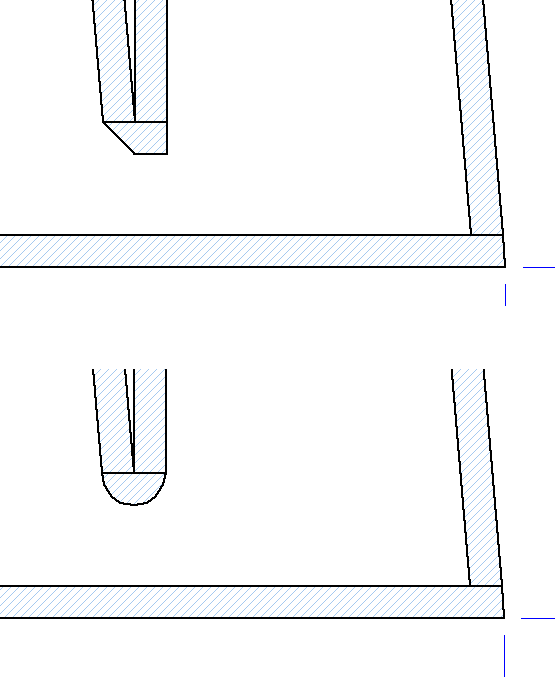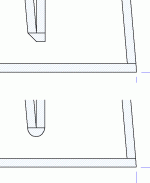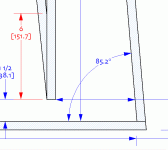Member
Joined 2009
Paid Member
A Voigt pipe in the usual parlance is a conical horn tuned to 1/4 wavelength (there are exceptions) of the desired Fo & is rarely impedance matched in its functional BW (again, with certain exceptions). It's basically a standing-wave generator; having positive expansion that means 1/2 wave with a 1/4 wave fundamental. The ripples in the FR are a function of the pipe harmonics, just as they are in a straight pipe, albeit with both odd and even harmonics. FH3 is a hypex (hyperboilc) corner-horn, impedance matched to a much lower frequency. Different flare profile, different results, far less harmonic ripple through it's functional BW.
I seem to recall talking about this before. FH3 approximates a hypex / hyperbolic horn profile with two conical expansion stages between which a choke is inserted per Olson which helps block unwanted higher frequencies (viz. shorter wavelengths) from passing in either direction. Said choke has almost zero effect on Fo. As a corner / rear-boundary loaded design the expansion thus continues outside the box, like any other corner / 1/4 space design.
Thanks for the reply Scott, I'm perhaps being lazy by asking too many questions although I did read MJK on horns yesterday there is still much more reading to do. Is there a reference you can give me where I can read up on this choke thing from Olson ?
OK, I have been following this thread and have been convinced that I want to build a pair. I sent an email about this last week, but I assume that you guys were rather busy. My wood shop class starts up again this Thursday and I don't have a project defined yet. There are forces trying to convince me to build a bigass P-P amp, but I have plenty of amps and am rather short on speakers. I will resend the email tonight in case it never made it.
I still associate the term as a voigt and have just quit using the term because its use as Scott defines is so confusing.
Blame GM & now me for confusing things by going back to the trad. definitions.
...tapering was seen as a key feature of a TL.
Yeah, odd there was so little done on that in the hifi world. Still, from a point of functionality, I suppose it was, with the mild mass loading of the air column probably being the real reason for the effects that were often attributed to fibre stuffing lowering the SoS.
Last edited:
OK, I have been following this thread and have been convinced that I want to build a pair. I sent an email about this last week, but I assume that you guys were rather busy..
Yes, sorry about that... busy, (having eaten up 10 dayd prepping for diyFEST), and then showing my age by taking nearly a week to get back up to full steam after.
FH3 is probably a very good choice.
dave
Blame GM & now me for confusing things by going back to the trad. definitions.Voigt pipe is a useful classification for a particular sub-category of chamberless conical pipe.
If you go back and read the voigt patent, which predates "TLs", all thou not explicit, all the language is there to call them Tapered Quarter Wave Pipes.
It is true that a bailey-like line is a chambered tapered 1/4 wave i cannot recall any reference to trad TLs being called TQWP.
dave
Yes, sorry about that... busy, (having eaten up 10 dayd prepping for diyFEST), and then showing my age by taking nearly a week to get back up to full steam after.
I understand, since the whole conversation started while I was in the middle of a 2900 mile road trip, which took me about a week to recover froom too. Not to mention missing work for 2 weeks, and now playing catch up. I'm sure you guys had more fun, but I did get to spend some time with the grand kids which was the first time in 2 years.
FH3 is probably a very good choice.
OK. Now which drivers.........
I heard a couple of Mark Audio drivers at LSAF, and I've been wanting to try them, I believe I'll order up a couple of CHR 70's for my build.
I'm going to imagine that they will need a little stuffing. From my examination of the plan, I'm going to do that " Assume " thing, and guess a little in the point above the driver, a little damping directly behind the driver, and maybe a little more on the bottom of the cabinet, if I get HF noise out of the port?
How large should the deflector be? Use the FH deflector as a guide, except make it taller?
John
I'm going to imagine that they will need a little stuffing. From my examination of the plan, I'm going to do that " Assume " thing, and guess a little in the point above the driver, a little damping directly behind the driver, and maybe a little more on the bottom of the cabinet, if I get HF noise out of the port?
How large should the deflector be? Use the FH deflector as a guide, except make it taller?
John
I'm going to imagine that they will need a little stuffing. From my examination of the plan, I'm going to do that " Assume " thing, and guess a little in the point above the driver, a little damping directly behind the driver, and maybe a little more on the bottom of the cabinet, if I get HF noise out of the port?
Close. We damped the V with an increasing density of poly fluff, and lined around the driver with cotton felt. This suitaed the FE126 well, a bit more damping is suggested by what we heard with the Mark Audios. The amount of bottom should be controllable with polyfluff below the driver.
How large should the deflector be? Use the FH deflector as a guide, except make it taller?
Yes. Doesn't need to be much taller, the old FH one worked fine (i have some of the original flat-paks of these left -- shipping + donation to the forum or the FH website)
dave
OK, I have been following this thread and have been convinced that I want to build a pair. I sent an email about this last week, but I assume that you guys were rather busy. My wood shop class starts up again this Thursday and I don't have a project defined yet. There are forces trying to convince me to build a bigass P-P amp, but I have plenty of amps and am rather short on speakers. I will resend the email tonight in case it never made it.
George - thanks for your patience - ahyup, the past week or so have been a bit hectic, but look for a private reply from Dave shortly.
The only suggestion I'd make to anyone trying this design is to splurge on high density plywood such a Baltic birch, or Apple Ply. 15mm is fine for this project.
Dave now has CAD cut sheet plans for both 5x5ft BB and more conventional 4x8ft sheets. Our first pair was partly built with offcuts from other projects, so I didn't prepare these cut plans until after the fact. As I tend to be a bit of a fuss-azz about grain pattern, particularly if the boxes are to receive a natural finish, I took pains to lay this out to maintain consistent direction on all visible surfaces.
That makes for a very tight fit on a 5x5sheet, but with careful layout and cutting sequence, as well as the use of an MDF template and router with pattern following bit, it can be done. Actually, that part could make it quite a bit more interesting than if material yield and CNC time is not an issue.
How tight is it? - if nesting the pattern for CNC routing, you'd probably want to override the yield optimization portion of software if present to maintain grain direction, change cutting bit to 1/4", and reduce feed rate.
If you go back and read the voigt patent, which predates "TLs", all thou not explicit, all the language is there to call them Tapered Quarter Wave Pipes.
Agreed. As far as I'm concerned, they're still horns though. Anything that expands toward the terminus is technically a horn, as you're progressively shifting away from the nominal behaviour of a closed (at one end) cylinder toward that of a closed cone. I don't tend to view impedance matching to Fo as a defining characteristic of horns, more a (potential) design goal depending on the requirements in question.
It is true that a bailey-like line is a chambered tapered 1/4 wave i cannot recall any reference to trad TLs being called TQWP.
As in reverse-taper? As I recall from Greg, it's early WE / Altec engineer's nomenclature. Works for Greg & myself (possibly a handful of others) although admittedly it's ideosyncratic in the current environs.
Doesn't really matter in the great scheme of things, but interesting for all that.
Last edited:
I'd like to see that...
Early WE & Altec pre-date the 1/4 wave TL by quite a bit,and Voigts use of the terms predate them (not WE, but the firm that WE & AT&T formed that became Altec 10 years later). Onley's Labirynth patent was in 1936 but that is not a TL, just a precursor,
Immaterial anyway as terminology does evolve. Despite what WE & Altec may have used, TQWT is now synonomous with a voigt pipe, particularily in the modern TL era with MJK's ML-TQWT article.
dave
Early WE & Altec pre-date the 1/4 wave TL by quite a bit,and Voigts use of the terms predate them (not WE, but the firm that WE & AT&T formed that became Altec 10 years later). Onley's Labirynth patent was in 1936 but that is not a TL, just a precursor,
Immaterial anyway as terminology does evolve. Despite what WE & Altec may have used, TQWT is now synonomous with a voigt pipe, particularily in the modern TL era with MJK's ML-TQWT article.
dave
IIRC the subject was raised on one of his visits to Altec. My assumption is by that stage they'd adopted the TL phrase for straight pipes over the trad. air-coupler or labyrinth.
If there's positive expansion I just call them horns (or mass loaded horns if appropriate). Makes things a whole lot simpler.
If there's positive expansion I just call them horns (or mass loaded horns if appropriate). Makes things a whole lot simpler.
Last edited:
Enuff of this side discussion of terminology...
I had the question asked today about 3/4" material. Without resorting to a Tenon jig, that further compromises the maximum "1 material width" length of the choke point.
Do you think something like the attached use of half-round would work,
dave
I had the question asked today about 3/4" material. Without resorting to a Tenon jig, that further compromises the maximum "1 material width" length of the choke point.
Do you think something like the attached use of half-round would work,
dave
Attachments
And if some of you are wondering where we are coming from or what we are talking about, here is the original concept which was modified in the interests of ease of build. Even if you have a tenon jig, not many saws will give you 6" of blade to cut with
dave
dave
Attachments
There are a number of ways that could be cut. What is required is a Scarphing/scarfing jig.
I'm going to use some ~1" ply that I have access to in offcuts. That is how I planned to make the join...except I was going to scarf the ( in my case thinner ) inner divider, and 1/4 round the back part per the plan. I have to make a full size drawing to work from when I do these things anyway. That will allow me to maintain the inner dimensions per plan.
The scarf cut can be made with a variety of tools, from a simple block plane, to a belt sander, or a router ( manual or CNC ). That join is used in wooden boat construction to end join 2 pieces of wood where strength needs to be maintained, Eg: a birds mouth mast layup, or end joining ply for skinning a bottom. It's approximately a 10:1 scarf cut.
FYI
John
I'm going to use some ~1" ply that I have access to in offcuts. That is how I planned to make the join...except I was going to scarf the ( in my case thinner ) inner divider, and 1/4 round the back part per the plan. I have to make a full size drawing to work from when I do these things anyway. That will allow me to maintain the inner dimensions per plan.
The scarf cut can be made with a variety of tools, from a simple block plane, to a belt sander, or a router ( manual or CNC ). That join is used in wooden boat construction to end join 2 pieces of wood where strength needs to be maintained, Eg: a birds mouth mast layup, or end joining ply for skinning a bottom. It's approximately a 10:1 scarf cut.
FYI
John
According to Augspurger it was Bailey who came up with the term transmission line to describe the speaker in his seminal 1965 article. If that is indeed the case, then the Bailey TL is the very definition.
Well the cabinet described in the title certainly is, even though the enclosure itself doesn't manage. No matter.
I had the question asked today about 3/4" material. Without resorting to a Tenon jig, that further compromises the maximum "1 material width" length of the choke point.
Do you think something like the attached use of half-round would work
Should do fine.
hi,
newbie here, been lurkin for some time but been holding off building fh's when i read the fh3 was going to be a simpler and easier to build design.
Really excited about building a pair of fh3's and more then happy to provide feedback and contribute to the forum/plan set....from a beginners perspective (apologies in advance for any stupid questions).
big thanks to the designers and people involved in the project for all their knowledge, skill and hardwork
jais
newbie here, been lurkin for some time but been holding off building fh's when i read the fh3 was going to be a simpler and easier to build design.
Really excited about building a pair of fh3's and more then happy to provide feedback and contribute to the forum/plan set....from a beginners perspective (apologies in advance for any stupid questions).
big thanks to the designers and people involved in the project for all their knowledge, skill and hardwork
jais
a few comments from someone who has actually built these things (using 15mm (5/8") BB plywood);
- I didn't have any half-round molding in the shop when I blasted the "proof of concept" pair together and the upper of the two shown in Dave's sketch is pretty darned simple - that's a 45 bevel - the most acute angle cut in the project.
- For added strength, I air-nailed a few short brads from the "inside", before attaching the front panel - some construction adhesive or expanding PUR Gorilla glue at the "pointy end" wouldn't hurt either
- One of the goals of this design was simplicity of build; while as John points out there's a couple of creative ways to accomplish this particular joint, but they might well be beyond the skill set or comfort zone of potential DIY builders ( this is not a boat or James Krenov sideboard), so I personally opted for the down and dirty method shown. No doubt any experienced craftsman could make the required modifications to plans to achieve their own preferred method of assembly, but don't change the critical dimensions.

as for terminology; this conversation sounds vaguely familiar - ( expunged Decware threads circa 5? yrs ago):
"words mean what I say they do" - (until I change my mind, or actually research the subject, in which case it'll be time to deflect to another subject) "
- I didn't have any half-round molding in the shop when I blasted the "proof of concept" pair together and the upper of the two shown in Dave's sketch is pretty darned simple - that's a 45 bevel - the most acute angle cut in the project.
- For added strength, I air-nailed a few short brads from the "inside", before attaching the front panel - some construction adhesive or expanding PUR Gorilla glue at the "pointy end" wouldn't hurt either
- One of the goals of this design was simplicity of build; while as John points out there's a couple of creative ways to accomplish this particular joint, but they might well be beyond the skill set or comfort zone of potential DIY builders ( this is not a boat or James Krenov sideboard), so I personally opted for the down and dirty method shown. No doubt any experienced craftsman could make the required modifications to plans to achieve their own preferred method of assembly, but don't change the critical dimensions.

as for terminology; this conversation sounds vaguely familiar - ( expunged Decware threads circa 5? yrs ago):
"words mean what I say they do" - (until I change my mind, or actually research the subject, in which case it'll be time to deflect to another subject) "
Last edited:
- Home
- Loudspeakers
- Full Range
- Frugel-Horn Mk3

